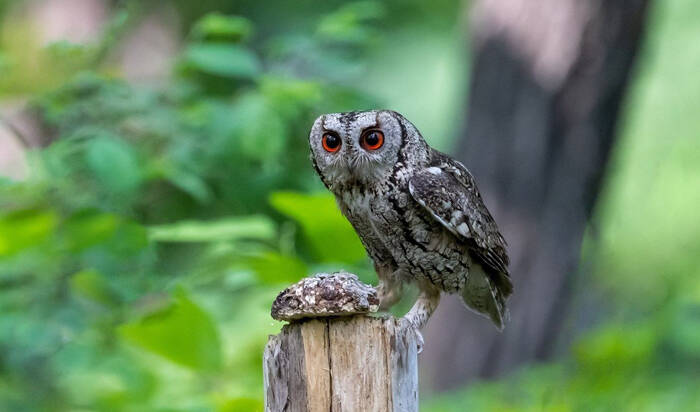Otus semitorques
IUCN
LCBasic Information
Scientific classification
- name:Otus semitorques
- Scientific Name:Otus semitorques,Japanese Scops-owl
- Outline:Raptor
- Family:Strigiformes Strigiformes Owl
Vital signs
- length:23-25cm
- Weight:100-170g
- lifetime:5-7years
Feature
The body has dark brown fine worm-like feathers
Distribution and Habitat
Distributed in Eurasia, including Northeast China, Korea, Ussuriland, Japan and the Ryukyu Islands.
Inhabits hilly to mountainous and lowland forests, wooded plains, and lives in open areas such as wooded areas, desert edges, open countryside and forest steppes. Up to 900 meters above sea level on mountain slopes; in winter in parks and gardens. In Japan, it also breeds in tree holes in temples and shrines.
Appearance
The Northern Scops Owl is 23-25 cm long. Wingspan 54-60 cm. Both sexes are the same color, with gray upper body parts and dark brown fine worm-like feathers. Wings are dark brown, with white light yellow stripes on the outer vanes of primary flight feathers, and fine worm-like feathers on the inner vanes; there is a white band on the shoulder blades. The tail is brownish gray with narrow white stripes and fine brown worm-like feathers. The underparts are grayish brown with dark stripes, and the feathers have dark brown shafts and some have fine brown lines. The bird's beak is green and the feet are gray.
Details
The Japanese Scops-owl is called Japanese Scops-owl in English and has three subspecies.

The Northern Scops Owl was once a subspecies of "Otus bakkamoena semitorques" (Japanese subspecies of Scops Owl), and was classified as an independent species in 2014.
The Northern Scops Owl is a resident bird, but due to the high number of bird landings and observations in winter, it is considered a winter bird in some prefectures in Japan. This species is nocturnal, and males make a "buzzing" sound during the breeding season, but they do not make a loud sound like the Red Scops Owl, and because it is active at night, it is rarely confirmed. The nest is a hole in a large tree and a bridge. It preys on mice, birds, frogs and insects. Listed in the IUCN Red List of Threatened Species in 2016 ver3.1 - Least Concern (LC).
Listed in Appendix I, II and III of the Convention on International Trade in Endangered Species of Wild Fauna and Flora (CITES) 2019 Edition Appendix II.
Listed in China's "National Key Protected Wildlife List" (February 5, 2021) Level 2.
Protect wildlife and eliminate game.
Maintaining ecological balance is everyone's responsibility!








